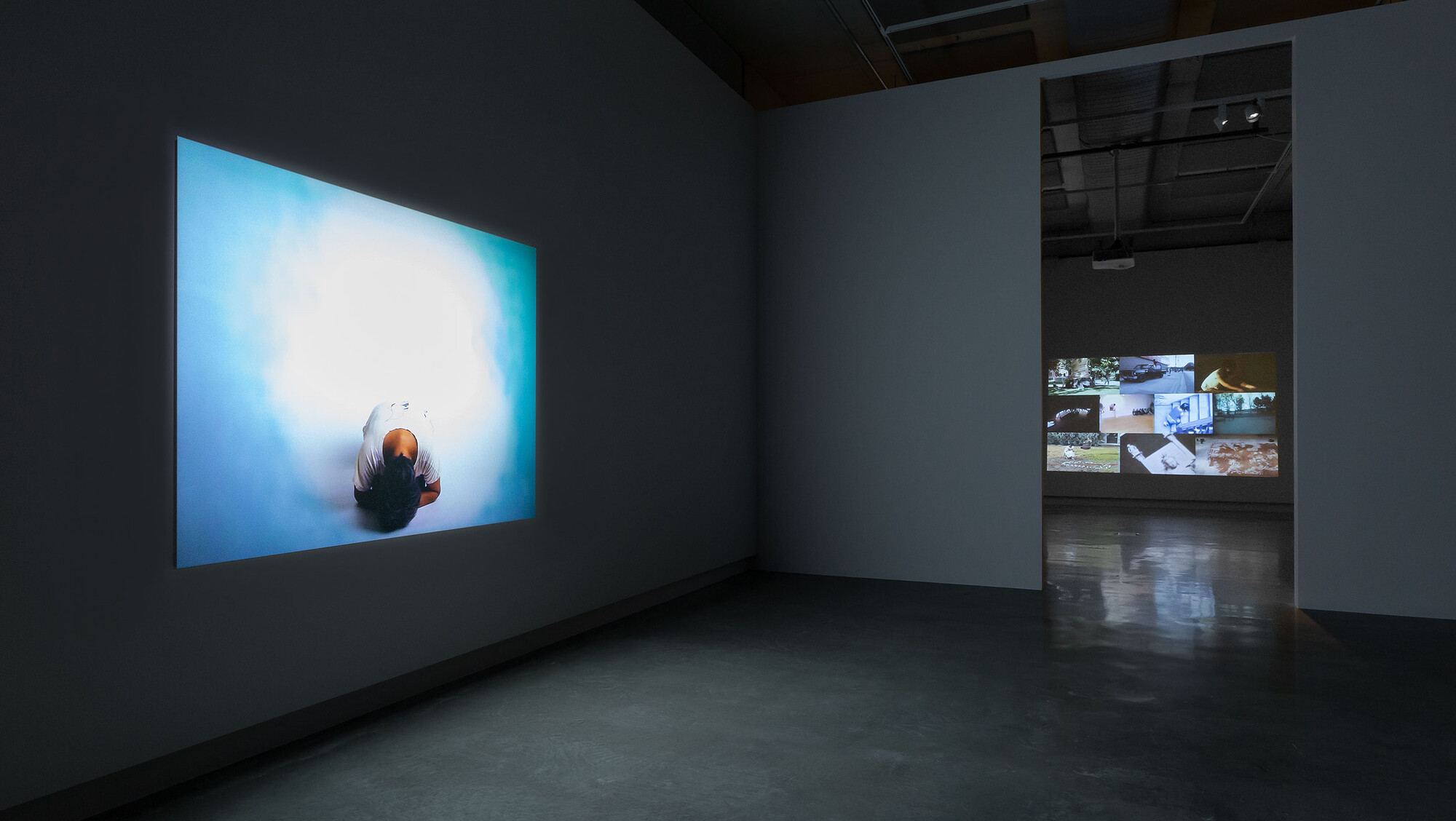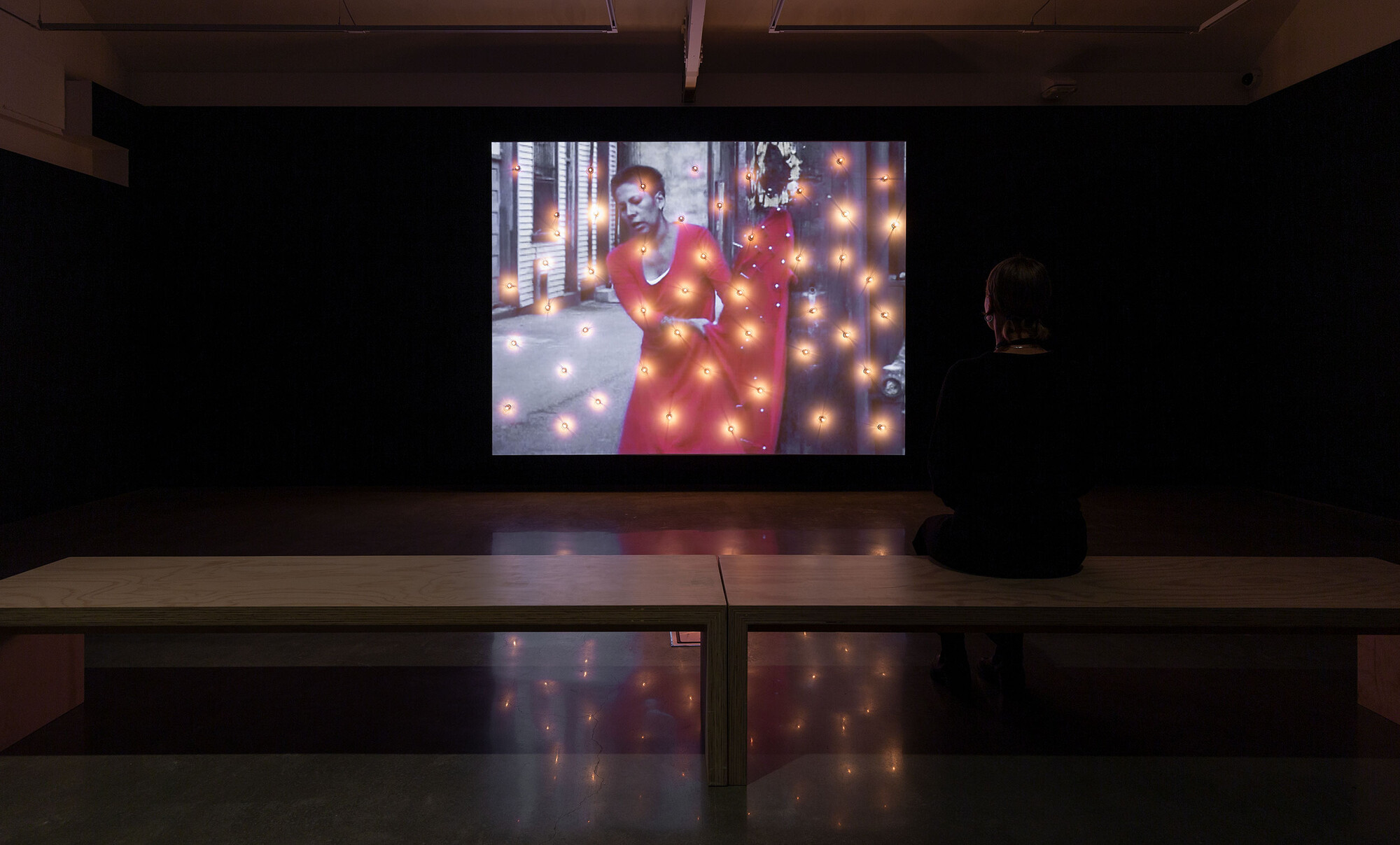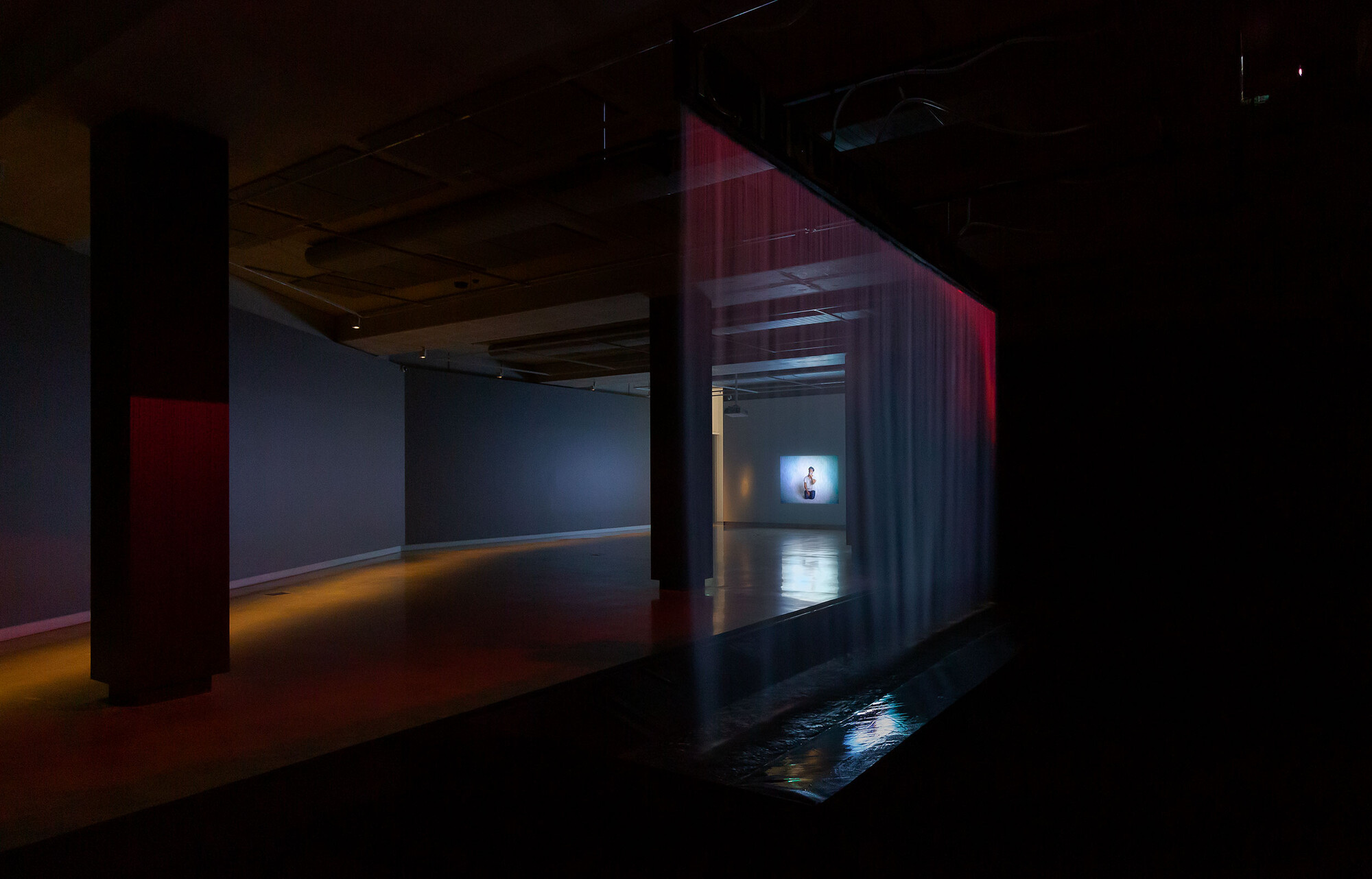Rebecca Belmore: Turbulent Water
Tim Riley Walsh
Turbulent Water is an exhibition of just four works. Despite its economy, it cuts deep: surveying in succinct fashion the over three-decade career of the artist Rebecca Belmore, a member of the Lac Seul First Nation (Anishinaabe).
The power of Belmore’s work in this exhibition lies in its potent material and conceptual consistency. It is embedded in the context of performance art and yet retains an innovative, exploratory spirit, utilising inventive means of display that recall the artist’s early interest in sculpture. Though Belmore is a near-constant presence in the works, the works themselves strike in differing and affecting ways.
Perimeter (2013) is a video performance work that conflates the banal dominance of colonial extraction with cultural connection to land and place, while The Named and Unnamed (2007) turns previous documentation into a sculptural, wall-based video projection. The original recorded performance, created in the aftermath of the serial murders of several Indigenous women in Vancouver, is a pained howl of rage, of love, of reverence. Fountain (2005) is a large-scale video installation that commands the gallery’s central space with a torrent of falling water, which Belmore employs as a dramatic projection screen. And Apparition (2013), modest in scale and content, offers an appropriately contrasting farewell, with Belmore’s crouched form quietly disappearing.

Water is a persistent theme throughout the show. As our shared life source, water is agitated by political resistance and cultural knowledge. Across the exhibition’s course, these significations fluctuate: between violence and vitality, blood and water. Water, blood, land and performance all suggest the landscape is a body itself.
Entering Turbulent Water, the viewer is greeted by Perimeter. The work incorporates a large-scale projected video and an accompanying text on the opposing wall in high-vis orange, which reads, “somewhere between a town a mine and a reserve is a line”. The twenty-minute video plays on the fluidity of this phrase, with Belmore traversing freely across these demarcated spaces, alluding to the arbitrariness of lines, borders and thresholds—-colonial inventions of organisation and control—-and reminding the viewer of their own engrained presence. In the work, Belmore dons a surveyor’s vest in matching neon and traverses landscapes around Sudbury, Ontario, which have been part of Anishinaabe lands for thousands of years before its co-option by nickel mining in the late-nineteenth century. Belmore traces various linear formations: a highway snaking toward the horizon in the rain; a suburban street undulating toward a vast factory; a pipeline coursing up a hillside. The structures of industry and the urban sprawl that comes with it dominate most shots. Perimeter shows that these structures are painfully familiar, the gross mundanity of extractive logic preying on sacred lands.

This sense of the familiar permeates Perimeter. All too often, discussion of extraction-ravaged landscapes turns to science-fiction for adjectives. They are said to be otherworldly, dystopian, alien. But they are here right now and far from fictive. Belmore’s travels in Perimeter take her across a private nickel mine, the city itself and the Atikameksheng Anishnawbek (Whitefish Lake) First Nation. Sudbury’s landscape remains decimated by the infrastructure of nickel extraction. Canada is also dominated by vast pipeline networks spanning nearly one-million kilometres over and under its landscapes. We watch every slow step of Belmore as she follows the pipe, treading a local path. The next shot shows its dank mouth dribbling runoff into a vast body of grime, extending toward what looks like the Inco Superstack on the right of the shot, exhaling freely into the sky—-the tallest chimney in the Western hemisphere.
A sense of threat permeates Perimeter, echoed by an intermittent droning guitar note like a dragging noise being pulled slowly headfirst into a slag heap. At points, Belmore darts across the screen in a flash, wearing a fluorescent vest like a thriller film’s antagonist—-these brief moments of human activity allude to the human culpability for the mess of infrastructure. Contrasting scenes offer lifting presences though: an intercutting high shot of Belmore from behind sees her standing and looking into the still surface of a clear lake. The water’s skin describes a tableau of natural beauty, gradating from crystal clear pool in the lower half to blue sky reflection in the top. The work repeatedly returns to this scene, such is its intensity—-deep lessons clearly lie under the surface.
For much of Perimeter, Belmore carries a surveying tape. Neon in colour and held in the artist’s hand, it is dragged behind her throughout the film. Naturally, the surveying tape divides and separates, carving up the landscape like a knife. At the film’s start, we don’t see the end of the tape. As the work progresses, the fluorescent strip is revealed as finite. The capacity for industry to extract and speculate is never ending. Things are not as they seem; transformation is possible. Belmore invokes poetic association to undo the borderline’s power of definition. Suddenly it is like a playful tail, slipping through the landscape, or perhaps the trail of a gymnast’s ribbon caught in an energising wind. Next, the cold, machine-powered leeching of the planet is countered with the active human body. Hands slap, touch, and rub rock and earth. It is a sudden and overtly human action, pitting intimacy against distant and automated extraction.

When I arrived in the space, somewhere in the work’s loop, spectral wisps seemed to hover over a scene of a rocky gorge. As the film returned to this point again, I saw them anew, an engrained, irremovable presence—-a different kind of permanence beyond the reach of pipeline or plow or border. Belmore and the presence of Belmore’s body in these works is more obviously and crucially about Indigenous bodies, and especially the bodies of Indigenous women as sites of colonial-led violence—-yet also powerful defiance. In the context of the climate crisis, reference must also be made to gendered climate impact—-that climate change is disproportionality experienced based on gender.
Gendered violence informed by ongoing colonisation is the focus of The Named and Unnamed, the second work in Turbulent Water. The piece combines a series of lit bulbs dispersed on the gallery wall over which a projected video work plays. The moving image documents a 2002 performance titled Vigil. The original performance was conceived after the serial killer Robert Pickton was charged with the murder of twenty-six women in Vancouver, many of whom were Indigenous. Belmore screams the names of these women in the performance and scrawls them on her arms—-giving voice to the pain but also acknowledging the women through a series of reverential acts and public naming. At points, Belmore wears a red dress that she nails to a pole, struggling to free herself. By the end, looking perhaps for closure or reasoning, Belmore embodies the posture and attitude of a man—-strutting over to a pickup truck and leaning against it as James Brown’s “It’s a Man’s Man’s World” plays, settling pointedly, as Jolene Rickard notes, on the line: “This is a man’s man’s world/but it wouldn’t mean nothing, nothing/without a woman or a girl.”
Though trauma is present in this work, the artist offers a way to move beyond, past or through it—-opportunities for not just acknowledgment but also truth-telling and perhaps even amelioration. At the very beginning of The Named and Unnamed, Belmore cleans the sidewalk methodically and lights candles. The act is echoed by the addition of the faintly-glowing bulbs that visitors watch the performance through: a vigil that softly lights the viewing space and through which we pay our own form of reverence.
At the exhibition’s heart is Fountain. The work is a nearly ten-metre-long waterfall that pours from the ceiling of the gallery, functioning as a screen for a rear-projected video. In the video, a pyre is lit at the water’s edge, and we see and hear Belmore in the shallows, struggling with a large metal bucket: grunting, groaning to fill it, despite her (and the bucket’s) near-total immersion. Now on the shore, she flings its contents directly at the camera (and us) where it coats the image in translucent red. At the time of its first public presentation within the Canadian Pavilion at the Venice Biennale, Belmore was the first Indigenous woman to represent Canada. Beyond this, the work exemplifies (unsurprisingly) a particular standard of large-scale video installation. But that scope does not limit Belmore’s attentiveness to detail and poetics. Approaching the work, a cool wind picks up and a light spray coats my arms, hair follicles stand on end. Like the bulbs’ electric current from The Named and Unnamed, a buzz runs through me. A too earnest reading of the red—-like the tinted door at the exhibition’s beginning—-would simply see pain in Belmore’s action toward the camera. Of course, red and blood are part of pain, but clearly it is about vitality too. I feel a surge of energy.
The final work, Apparition, though quieter than the three that came prior, speaks to another form of disappearance and loss—-specifically the loss of Indigenous languages in the context of Canadian government sponsored schools that stole First Nations children from their families and communities for more than a century and a half. We see Belmore again, now bowed over—-looking toward us but then vanishing soon after from the screen. Belmore’s disappearance does not last long. In the exhibition’s final space, an archive of selected performance documentation is provided for visitors who wish to dig deeper into the artist’s important oeuvre. As both Apparition and the archive are less dominant in their display, these last moments move back in prominence in comparison to the three works already experienced.

Turbulent Water is curated by Wanda Nanibush, Curator, Indigenous Art at the Art Gallery of Ontario, and Angela Goddard, Director of Griffith University Art Museum. It is surprising that this is the first exhibition of its kind in Australia to profile Belmore, especially considering the local resonance of the Vancouver-based, Upsala-born artist’s practice. The colonial invasions of the lands and waters of the First Nations of Canada recalls with numbing similarity the violence against—-and attempted assimilation of—-Indigenous Australians. These shared histories undergird the show, hanging in the air like a pressing hum and tinting my vision.
Belmore’s work speaks with force and nuance about the necessity of sovereign cultural knowledge and its protection and cultivation, as well as other pressing and shared issues: gendered violence, environmental destruction, un-ending resource extraction. These issues loop back to inform a fuller, more critical understanding of the root causes of the climate crisis. This is one that recognises cries of apocalyptic tidings in the present must be framed by a deeper recognition of the various apocalypses carried out on and experienced by Indigenous peoples globally through colonisation—-an acknowledgement guiding scholars Zoe Todd and Heather Davis’s argument that the Anthropocene began not in the mid-twentieth century but in 1610 with the invasion of the Americas. T. J. Demos helpfully frames this imbrication as “ecology-as-intersectionality”, recognizing that threats against First Nations and Indigenous communities, cultures and sovereignty are inseparable from threats against the Earth’s environments, as are “police brutality, media censorship, and capitalist growth”.
At the heart of the strength of Belmore’s work is its pulsing, at times all enveloping, sense of conviction. The artist’s presence repeatedly crosses the screen to grab us. In The Named and Unnamed, when Belmore picks up a short-handled broom to sweep the space in Downtown Vancouver where she is to perform for the waiting audience, she gestures, she steps, she moves and in all facets holds attention. Belmore seems to avoid the not-quite-felt-enough of much contemporary performance practice—-that cloying sense that a work never escapes its own self-aware orbit and is instead present, clear and ultimately generative. Belmore’s art achieves this exit beyond itself because it remains embedded in truth: the knowledge and experience to communicate histories of dispossession but also joy, struggle, and the critical importance of sovereignty, especially as the waters grow rougher still.
Tim Riley Walsh is a curator, art historian and writer based in Naarm Melbourne. He is Curator in Residence at Gertrude.


